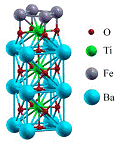Department of Physics and Astronomy: Publications and Other Research
Date of this Version
2016
Citation
PHYSICAL REVIEW B 94, 014435 (2016)
Abstract
The spin-helical surface states in a three-dimensional topological insulator (TI), such as Bi2Se3, are predicted to have superior efficiency in converting charge current into spin polarization. This property is said to be responsible for the giant spin-orbit torques observed in ferromagnetic metal/TI structures. In this work, using first-principles and model tight-binding calculations, we investigate the interface between the topological insulator Bi2Se3 and 3d-transition ferromagnetic metals Ni and Co. We find that the difference in the work functions of the topological insulator and the ferromagnetic metals shift the topological surface states down about 0.5 eV below the Fermi energy where the hybridization of these surface states with the metal bands destroys their helical spin structure. The band alignment of Bi2Se3 and Ni (Co) places the Fermi energy far in the conduction band of bulk Bi2Se3, where the spin of the carriers is aligned with the magnetization in the metal. Our results indicate that the topological surface states are unlikely to be responsible for the huge spin-orbit torque effect observed experimentally in these systems.


Comments
©2016 American Physical Society